Emerald
| Emerald | |
|---|---|
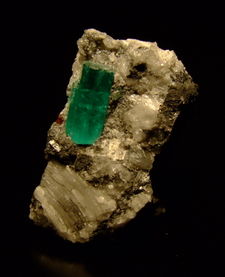 Emerald crystal from Muzo, Colombia |
|
| General | |
| Category | Beryl variety |
| Chemical formula | Be3Al2(SiO3)6 |
| Crystal symmetry | (6/m 2/m 2/m) - Dihexagonal Dipyramidal |
| Unit cell | a = 9.21 Å, c = 9.19 Å; Z = 2 |
| Identification | |
| Molar mass | 537.50 |
| Color | Green, Blue, Yellow, Colorless, Pink & others. |
| Crystal habit | Massive to well Crystalline |
| Crystal system | Hexagonal (6/m 2/m 2/m) Space Group: P 6/mсc |
| Cleavage | Imperfect on the [0001] |
| Fracture | Conchoidal |
| Mohs scale hardness | 7.5–8 |
| Luster | Vitreous |
| Streak | White |
| Diaphaneity | Transparent to opaque |
| Specific gravity | Average 2.76 |
| Optical properties | Uniaxial (-) |
| Refractive index | nω = 1.564–1.595, nε = 1.568–1.602 |
| Birefringence | δ = 0.0040–0.0070 |
| Ultraviolet fluorescence | None (some fracture filling materials used to improve emerald's clarity do fluoresce, but the stone itself does not) |
| References | [1] |
Emeralds are a variety of the mineral beryl (Be3Al2(SiO3)6) colored green by trace amounts of chromium and sometimes vanadium.[2] Beryl has a hardness of 7.5–8 on the 10 point Mohs scale of mineral hardness.[2] Most emeralds are highly included, so their toughness (resistance to breakage) is classified as generally poor.
Contents |
Etymology
The word "Emerald" is derived (via Old French: Esmeraude and Middle English: Emeraude), from Vulgar Latin: Esmaralda/Esmaraldus, a variant of Latin Smaragdus, which originated in Greek: σμάραγδος (smaragdos; "green gem"); its original source being either the Hebrew word אזמרגד izmargad meaning "emerald" or "green"[3] or the Sanskrit word मरग्दम् marakata meaning "green." The name could also be related to the Semitic word baraq (בָּרָק ;البُراق; "lightning" or "shine") (cf. Hebrew: ברקת bareqeth and Arabic: برق barq "lightning"). It is the same source for the names Persian (زمرّد zomorrod), Turkish (zümrüt), Sanskrit (मरग्दम् maragdam), Russian (изумруд; izumrud)[4] and Armenian zmruxt.
Properties determining value
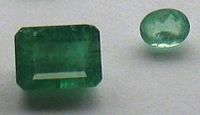
Emeralds, like all colored gemstones, are graded using four basic parameters, the four Cs of Connoisseurship; Color, Cut, Clarity and Crystal. The last C, crystal is simply used as a synonym that begins with C for transparency or what gemologists call diaphaneity. Before the 20th century, jewelers used the term water as in "a gem of the finest water"[5] to express the combination of two qualities, color and crystal. Normally, in the grading of colored gemstones, color is by far the most important criterion. However, in the grading of emerald, crystal is considered a close second. Both are necessary conditions. A fine emerald must possess not only a pure verdant green hue as described below, but also a high degree of transparency to be considered a top gem.[6]
In the 1960s the American jewelry industry changed the definition of 'emerald' to include the green vanadium bearing beryl as emerald. As a result, vanadium emeralds purchased as emeralds in the United States are not recognized as such in the UK and Europe. In America, the distinction between traditional emeralds and the new vanadium kind is often reflected in the use of terms such as 'Colombian Emerald.'[7]
Color
Scientifically speaking, color is divided into three components: hue, saturation and tone. Yellow and blue, the hues found adjacent to green on the spectral color wheel, are the normal secondary hues found in emerald. Emeralds occur in hues ranging from yellow-green to blue-green. The primary hue must, of course, be green. Only gems that are medium to dark in tone are considered emerald. Light-toned gems are known by the species name, green beryl. In addition, the hue must be bright (vivid). Gray is the normal saturation modifier or mask found in emerald. A grayish green hue is a dull green.
Clarity
Emerald tends to have numerous inclusions and surface breaking fissures. Unlike diamond, where the loupe standard, i.e. 10X magnification, is used to grade clarity, emerald is graded by eye. Thus, if an emerald has no visible inclusions to the eye (assuming normal visual acuity) it is considered flawless. Stones that lack surface breaking fissures are extremely rare and therefore almost all emeralds are treated, "oiled", to enhance the apparent clarity. Eye-clean stones of a vivid primary green hue (as described above) with no more than 15% of any secondary hue or combination (either blue or yellow) of a medium-dark tone command the highest prices.[6] This relative crystal non-uniformity makes emeralds more likely than other gemstones to be cut into cabochons, rather than faceted shapes.
Treatments
Most emeralds are oiled as part of the post lapidary process, in order to improve their clarity. Cedar oil, having a similar refractive index, is often used in this generally accepted practice. Other liquids, including synthetic oils and polymers with refractive indexes close to that of emerald such as Opticon are also used. The U.S. Federal Trade Commission requires the disclosure of this treatment when a treated emerald is sold.[8] The use of oil is traditional and largely accepted by the gem trade. Other treatments, for example the use of green-tinted oil, are not acceptable in the trade. The laboratory community has recently standardized the language for grading the clarity of emeralds. Gems are graded on a four step scale; none, minor, moderate and highly enhanced. Note that these categories reflect levels of enhancement not clarity. A gem graded none on the enhancement scale may still exhibit visible inclusions. Laboratories tend to apply these criteria differently. Some gem labs consider the mere presence of oil or polymers to constitute enhancement. Others may ignore traces of oil if the presence of the material does not materially improve the look of the gemstone.
Given that the vast majority of all emeralds are treated as described above, and the fact that two stones that appear to be similar in quality may actually be quite far apart in treatment level, a consumer considering a purchase of an expensive emerald is well advised to insist upon a treatment report from a reputable gemological laboratory. All other factors being equal, a high quality emerald with an enhancement level graded moderate should cost 40–50% less than an identical stone graded none.
Emerald localities
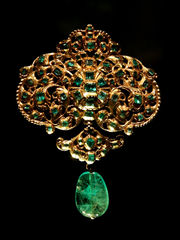
Emeralds in antiquity were mined by the Egyptians and in Pakistan and Austria.[9]
A rare type of emerald known as a trapiche emerald is occasionally found in the mines of Colombia. A trapiche emerald exhibits a "star" pattern; it has raylike spokes of dark carbon impurities that give the emerald a six-pointed radial pattern. Emeralds come from three main emerald mining areas in Colombia: Muzo, Coscuez, and Chivor. Emeralds are also found in other countries, such as Afghanistan, Australia, Austria, Brazil, Bulgaria, Cambodia, Canada, China, Egypt, Ethiopia, France, Germany, India, Italy, Kazakhstan, Madagascar, Mozambique, Namibia, Nigeria, Norway, Pakistan, Russia, Somalia, South Africa, Spain, Switzerland, Tanzania, United States, Zambia and Zimbabwe.[1] In the US, emeralds have been found in Connecticut, Montana, Nevada, North Carolina and South Carolina.[1] In 1998 emeralds were discovered in the Yukon.
Synthetic emerald
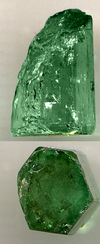
Emerald is a rare and valuable gemstone and, as such, it has provided the incentive for developing synthetic emeralds. Both hydrothermal and flux-growth synthetics have been produced, and a method has been developed for producing an emerald overgrowth on colorless beryl. The first commercially successful emerald synthesis process was that of Carroll Chatham. Because Chatham's emeralds do not have any water and contain traces of vanadate, molybdenum and vanadium, a lithium vanadate flux process is probably involved. The other large producer of flux emeralds was Pierre Gilson Sr., which has been on the market since 1964. Gilson's emeralds are usually grown on natural colorless beryl seeds which become coated on both sides. Growth occurs at the rate of 1 mm per month, a typical seven-month growth run producing emerald crystals of 7 mm of thickness.[10] Gilson sold his production laboratory to a Japanese firm in the 1980s, but production has ceased since; so did Chatham's, after the San Francisco earthquake in 1989.
Hydrothermal synthetic emeralds have been attributed to IG Farben, Nacken, Tairus, and others, but the first satisfactory commercial product was that of Johann Lechleitner of Innsbruck, Austria, which appeared on the market in the 1960s. These stones were initially sold under the names "Emerita" and "Symeralds", and they were grown as a thin layer of emerald on top of natural colorless beryl stones. Although not much is known about the original process, it is assumed that Leichleitner emeralds were grown in acid conditions. Later, from 1965 to 1970, the Linde Division of Union Carbide produced completely synthetic emeralds by hydrothermal synthesis. According to their patents,[11][12] acidic conditions are essential to prevent the chromium (which is used as the colorant) from precipitating. Also, it is important that the silicon-containing nutrient be kept away from the other ingredients to prevent nucleation and confine growth to the seed crystals. Growth occurs by a diffusion-reaction process, assisted by convection. The largest producer of hydrothermal emeralds today is Tairus in Russia. They have succeeded to synthesize emeralds that have similar chemical composition as emeralds in alkaline deposits in Colombia, hence they are called “Colombian Created Emeralds” or “Tairus Created Emeralds”.[13] Luminescence in ultraviolet light is considered a supplementary test when making a natural vs. synthetic determination, as many, but not all, natural emeralds are inert to ultraviolet light. Many synthetics are also UV inert.[14]
Synthetic emeralds are often referred to as "created", as their chemical and gemological composition is the same as their natural counterparts. The U.S. Federal Trade Commission (FTC) has very strict regulations as to what can and what cannot be called "synthetic" stone. The FTC says: "§ 23.23(c) It is unfair or deceptive to use the word "laboratory-grown," "laboratory-created," "[manufacturer name]-created," or "synthetic" with the name of any natural stone to describe any industry product unless such industry product has essentially the same optical, physical, and chemical properties as the stone named."[15]
Wispy veil-like inclusions are common in flux-grown synthetic emeralds.
Emerald in different cultures, and emerald lore

Emerald is regarded as the traditional birthstone for May, as well as the traditional gemstone for the astrological signs of Taurus, Cancer and sometimes Gemini. One of the more quaint anecdotes on emeralds was by the 16th-century historian Brantôme, who referred to the many impressive emeralds the Spanish under Cortez had brought back to Europe from Latin America. On one of Cortez's most notable emeralds he had the text engraved Inter Natos Mulierum non sur-rexit mayor ("Among those born of woman there hath not arisen a greater"; Man. XI, 11) which referred to John the Baptist. Brantôme considered engraving such a beautiful and simple product of nature sacrilegious and considered this act the cause for Cortez's loss of an extremely precious pearl (to which he dedicated a work A beautiful and incomparable pearl) and even for the death of King Charles IX of France who died soon after.[16]
In some cultures, the emerald is the traditional gift for the 55th wedding anniversary. It is also used as a 20th and 35th wedding anniversary stone.
The Authorized King James Version of the Bible, in Exodus 28:18 and 39:11, lists "emerald" as one of the precious stones in the breastplate of the high priest of the Jews; but modern consensus is that this is probably a mistranslation. (See Hoshen.)
Ireland is often referred to, especially in America, as the "Emerald Isle".[17]
In L. Frank Baum's The Wonderful Wizard of Oz, the city where the wizard rules is made of emerald, thus being called Emerald City. The sixth book in the series is named after it.
| Emerald | Origin |
|---|---|
| Gachala Emerald | Colombia |
| Chalk Emerald | |
| Bahia Emerald | Brazil |
Gallery
|
Left to right: The Indian Emerald Necklace, the Gachala Emerald crystal and the Mackay Emerald Necklace, all pieces from the National Museum of Natural History. |
The Chalk Emerald ring, containing a top-quality 37-carat emerald, also in the National Museum of Natural History. |
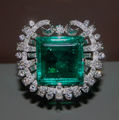 The Hooker Emerald Brooch, containing a 75-carat square-cut emerald, also in the National Museum of Natural History. |
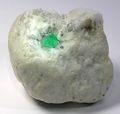 Emerald crystal (about 1 cm) in calcite matrix, Muzo, Colombia. |
 A top-quality 5-carat emerald from Muzo. |
See also
- List of minerals
References
- ↑ 1.0 1.1 1.2 "Emerald at Mindat". Mindat.org. 2010-07-19. http://www.mindat.org/min-1375.html. Retrieved 2010-07-30.
- ↑ 2.0 2.1 Hurlbut, Cornelius S. Jr, & Kammerling, Robert C., 1991, Gemology, p. 203, John Wiley & Sons, New York ISBN 0471526673
- ↑ Fernie, William Thomas, MD (1907). Precious Stones for Curative Wear; and other remedial uses; likewise the nobler metals. Bristol: John Wright & Co..
- ↑ Harper, Douglas. "emerald". Online Etymology Dictionary. http://www.etymonline.com/index.php?term=emerald.
- ↑ Tavernier, J. B. (1925) Travels in India by Jean Baptiste Tavernier, Baron of Aubonne; translated from the original French edition of 1676 with a biographical sketch of the author, notes, appendices, &c. by V. Ball. 2nd ed., edited by William Crooke; Vol. II, pp. 44, 58
- ↑ 6.0 6.1 Wise, R. W. (2001) Secrets of the Gem Trade: the connoisseur's guide to precious gemstones. Brunswick House Press ISBN 0972822380; p. 108
- ↑ Read, Peter (2008) Gemmology 3rd rev. ed. NAG Press; p. 218
- ↑ "Guides for the Jewelry, Precious Metals, and Pewter Industries". Ftc.gov. 1996-05-30. http://www.ftc.gov/bcp/guides/jewel-gd.shtm#%A7%2023.22%20Deception%20as%20to%20gemstones. Retrieved 2010-07-30.
- ↑ Giuliani, G. (2000). "Oxygen Isotopes and Emerald Trade Routes Since Antiquity". Science 287: 631. doi:10.1126/science.287.5453.631. http://horizon.documentation.ird.fr/exl-doc/pleins_textes/pleins_textes_7/b_fdi_53-54/010020866.pdf.
- ↑ Nassau, K., 1980, Gems Made By Man, Gemological Institute of America, ISBN 0873110161
- ↑ U.S. Patent 3,567,642
- ↑ U.S. Patent 3,567,643
- ↑ Karl Schmetzer, Dietmar Schwartz, Heinz-Jurgen Bernhardt, Tobias Hager “A new type of Tairus hydrothermally-grown synthetic emerald, colored by vanadium and copper” Journal of Gemmology of Gemmological Association of Great Britain, September, Vol. 30 (1-2) 2006-2007, pp. 59-74
- ↑ Hurlbut, Cornelius S. Jr, & Kammerling, Robert C., 1991, Gemology, p. 81, John Wiley & Sons, New York ISBN 0471526673
- ↑ "Guides for the Jewelry, Precious Metals, and Pewter Industries". Ftc.gov. 1996-05-30. http://www.ftc.gov/bcp/guides/jewel-gd.htm. Retrieved 2010-07-30.
- ↑ Kunz, George Frederick (1915). Magic of Jewels and Charms. Philadelphia: Lippincott Company. p. 305. ISBN 0766143228. http://books.google.com/?id=uj8vr0RC_EQC&pg=PA305.
- ↑ "The men of the Emerald Isle" is a phrase in William Drennan's "Erin". Oxford Dictionary of Quotations; 2nd ed. Oxford University Press; 1953; p. 189
Further reading
- Cooper, J.C. (Ed.) (1992). Brewer's Myth and Legend. New York: Cassell Publishers Ltd. ISBN 0-304-34084-7.
- Sinkankas, John (1994). Emerald & Other Beryls. Geoscience Press. ISBN 0-8019-7114-4
- Hurlbut, Cornelius S.; Klein, Cornelis (1985). Manual of Mineralogy (20th ed.). New York: John Wiley and Sons. ISBN 0-471-80580-7
- Weinstein, Michael (1958). The World of Jewel Stones. Sheriden House.
- Ali, Saleem H. (2006). The Emerald City: Emerald mining in Brazil (+Gemstone mining in other countries) http://www.uvm.edu/envnr/gemecology/brazil.html
- Ball, V., & Crooke, W., Travels In India by Jean-Baptiste Tavernier, Oriental Reprint Corporation, New Delhi, India.
External links
- Historical References of Emeralds (full texts on) Famous Emeralds, and many of full text references used here.
- ICA's Emerald Page International Colored Stone Emerald Page
- Webmineral Beryl Page Webmineral with crystallographic and mineralogical information
|
|||||||||||||||||||||||||||||||||||||||